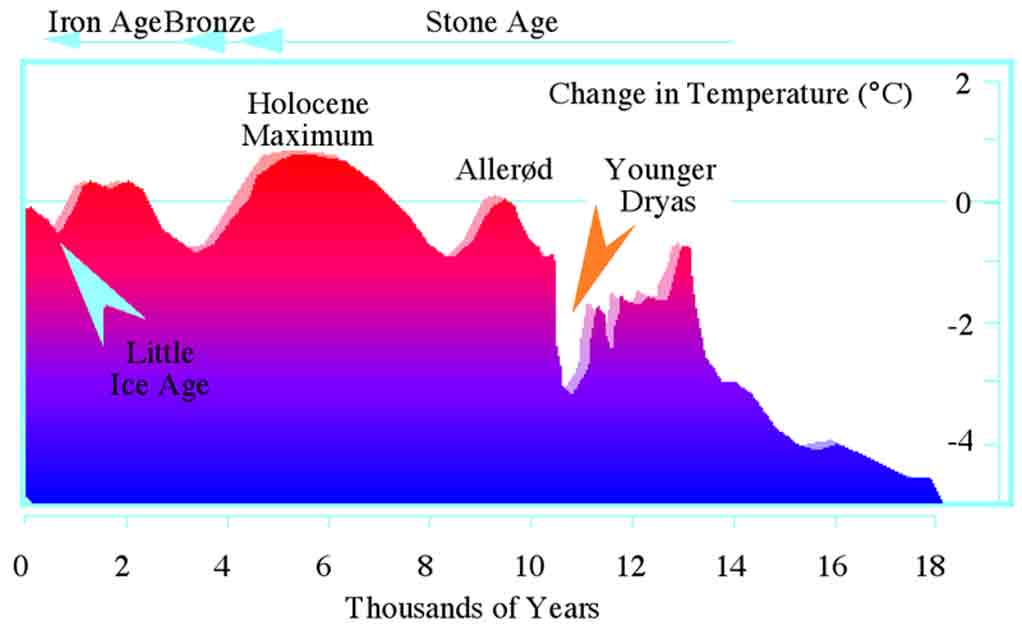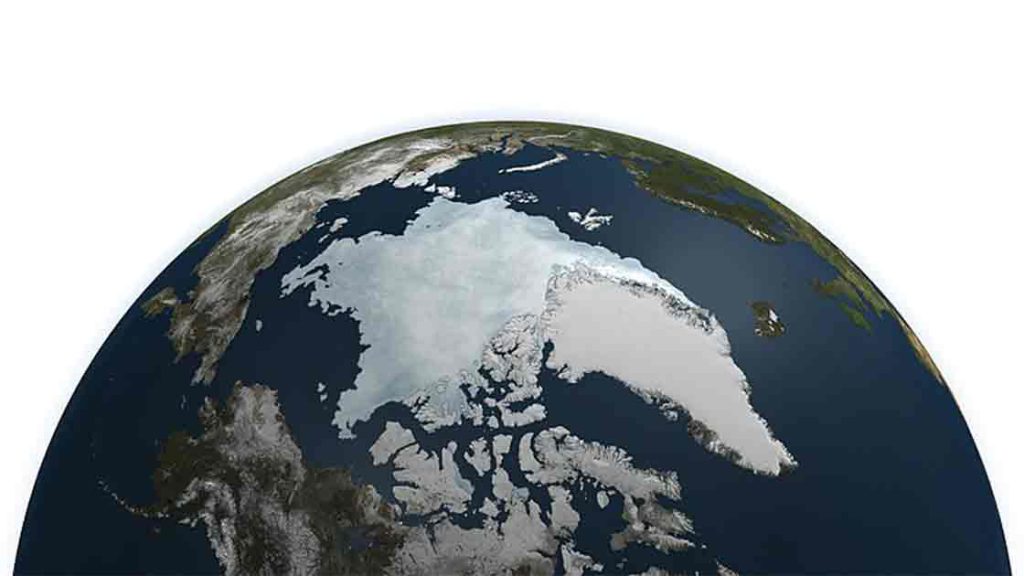The world we live in is changing. Whether you want to face it or not, enormous climate events are shaking the foundations of our society, and the clock is running out on our ecologically destructive way of living.
Rising sea level temperatures are leading to the deaths of entire ecosystems. Enormous fires tear through ancient forests, vast and extreme weather causes havoc through entire countries, and according to some models we have less than 20 years before the pressures on our global economy cause widespread collapse.
So what will this look like? Well, we may learn something from a look into our past, and what has happened when the climate changed rapidly before. In wondering what will happen to our world, lessons may be learned from the Younger Dryas Period.
If the history of our planet was a book, the Younger Dryas Period would be one of its shortest but most climatic chapters (literally). After a period of global warming that saw life beginning to thrive once again the Younger Dryas Period was a time of sudden and rapid cooling.
While the period was relatively short lived it reshaped landscapes and ecosystems, leaving a lasting imprint on our planet that can still be felt today. From its mysterious origins to its profound impacts, the Younger Dryas offers valuable insights into the dynamic nature of Earth’s climate system.
It may well be that the same thing does not happen to us this time: the circumstances and the causes are radically different. But as our climate goes through another period of dramatic change the lessons learned from the Younger Dryas are poignant than ever before.
A Major Cold Snap
Today we hear people talking about global warming all the time, and for good reason. The Younger Dryas Period was the exact opposite. It was a climatic anomaly, a period of aggressive global cooling that emerged roughly 12,900 years ago and persisted for around 1,200 years.

Named after a small, Arctic flower, the Dryas octopetala (which thrived in the frigid conditions created by global cooling), this period interrupted the gradual warming trend that had followed the last glacial maximum. This was the coldest point in the last glacial period that saw much of North America, Europe and Asia enveloped in massive ice sheets. It also preceded our current period, the much warmer Holocene epoch.
The Younger Dryas period’s existence was discovered by geologists through the study of various proxy records like the sampling of ice cores, sediment layers, and fossil evidence. During this chilly period, temperatures plummeted across most of the Northern Hemisphere, triggering massive and widespread environmental changes.
In particular, glaciers re-advanced into regions that had become free of ice, altering landscapes and ecosystems. Vast swathes of territory were covered in ice, the passage of which gouged out huge trenches and valleys across the landscape.
So, what caused it? Well, there are plenty of different theories, but we’ll stick to the most respected ones here. It’s widely believed that as the planet warmed up and entered the current interglacial period, the Holocene, the massive ice sheets that still covered large parts of North America began to melt.
In particular, the Laurentide Ice Sheet melted, dumping massive amounts of cool, freshwater into the North Atlantic. All this freshwater disrupted the delicate balance of oceanic circulation patterns that are key to regulating the Earth’s atmosphere. To put it another way, somewhat ironically, global warming led to an intense but brief period of cooling.
This fresh ice water disrupted the Atlantic Meridional Overturning Circulation (AMOC), a crucial component of global ocean circulation. The AMOC carries warm surface water from the tropics into the North Atlantic. Once there it releases heat into the atmosphere before sinking and returning southward at depth.
The freshwater from the melting ice sheets played havoc with this process, inhibiting the sinking of dense, salty water, and disrupting the northward transport of heat. No northward transportation of heat meant the North Atlantic experienced aggressive cooling. This is similar to what is happening to the Gulf Stream today.
Besides this freshwater influx, there are a handful of other factors that may have been at play. Firstly, changes in solar radiation, such as fluctuations in solar output or variations in Earth’s orbit (Milankovitch cycles), may have influenced climate patterns throughout this period.
Secondly, major volcanic eruptions can have a surprisingly dramatic effect on the climate. By dumping copious amounts of ash and gases into the atmosphere they can block out sunlight for extended periods leading to cooling. Shifts in atmospheric circulation patterns, such as alterations in the jet stream or changes in the position of atmospheric pressure systems, may have also played a role.
Our climate is made up of a maze of interconnected systems that we still don’t fully understand. When one system is disrupted, it can have a knock-on effect on the others, amplifying changes elsewhere.
Known as positive feedback loops, it’s believed this is what happened during the Younger Dryas Period. The influx of freshwater had a knock-on effect on other systems leading to dramatic climatic changes.
How the Earth Changed
The Younger Dryas Period had a major effect on the Earth’s landscapes and ecosystems. Ice cubes like to slip and slide, and glaciers are no different, just on a much bigger scale.

During this time the Earth’s glaciers, which had been steadily retreating since the last glacial maximum, abruptly re-advanced in regions previously thought to be ice-free. Nothing carves through rock like millions of tons of ice and these glaciers reshaped the topography, carving out valleys and leaving behind telltale moraines and other glacial landforms that still mark the landscape today.
It wasn’t just the planet’s topography that was changed. Freezing weather is also rather good at killing off vegetation.
- Human Evolution, and that Time we Faced Extinction
- Nemesis: Is There a Second Star in the Solar System?
As temperatures plummeted, forests retreated, creating tundra and steppe biomes in many areas. This ecological upheaval disrupted habitats, altering the distribution of plant and animal species, and forcing adaptation or migration to more hospitable areas.
These changes also left their mark on ancient human populations. Hunter-gatherer societies faced challenges as their accustomed habitats changed rapidly, leading to shifts in settlement patterns and subsistence strategies. The resurgence of cold, harsh conditions likely influenced cultural developments and technological innovations, as communities adapted to survive in the challenging environment.
The Younger Dryas Period may have been relatively short, but its legacy extends far beyond its 1,000-year duration, with its lingering impacts still observable in modern-day Earth systems. As we go through another period of rapid, unprecedented change, insights gained from studying this climatic anomaly provide valuable context for understanding and predicting present and future climate dynamics.
One significant impact is the lessons learned about the sensitivity of the Earth’s climate system to external forcings. In particular, it was once thought that massive climate changes took a long time to take effect.
The planet is incredibly old, and we’re used to talking in the hundreds of thousands or millions of years when talking about serious changes. However, the climate change that occurred here is believed to have taken effect over decades.
Furthermore, the Younger Dryas serves as a cautionary tale about the potential consequences of freshwater input into the ocean. If we’re right and the younger Dryas Period was primarily caused by melting ice sheets then that is something to consider as our own Arctic ice sheets melt, dumping water into the oceans. In a warming world where ice melts and changes in precipitation are accelerating, understanding the potential impacts on ocean circulation and climate stability is crucial for informed decision-making and mitigation efforts.

Additionally, the ecological disruptions caused by the Younger Dryas offer insights into how ecosystems respond to abrupt climate changes. Understanding past responses can inform conservation and management strategies in the face of ongoing climate change and habitat degradation.
A Lesson from History
The Younger Dryas Period exemplifies the dynamic and unpredictable nature of Earth’s climate system. From its complex origins to its far-reaching impacts, this dramatic period offers profound insights into the complexities shaping our planet’s past, present, and future.
As we unravel its secrets through scientific inquiry, the Younger Dryas serves as a reminder of the resilience and adaptability of life in the face of environmental upheaval. By studying this pivotal moment in Earth’s history, we gain not only knowledge but also a deeper understanding of the challenges and opportunities presented by a changing climate.
Top Image: The Younger Dryas period destroyed multiple ecosystems in only a few decades. Source: kichigin19 / Adobe Stock.